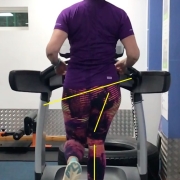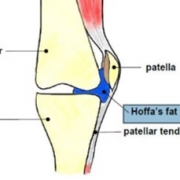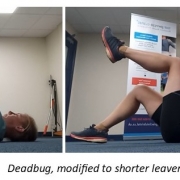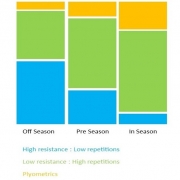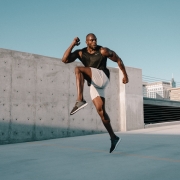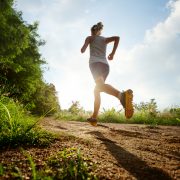Blog – Jenny’s knee injury (4)
/in Physiotherapy Advice, Running, Training, Triathlon training/by Pete TangHow should strength and plyometric training vary throughout your run season and training?
/in Articles, Running, Training, Triathlon training/by Pete TangWhat are plyometrics & why should you include them in your run training?
/in Articles, Running, Training, Triathlon training/by Pete TangWhat are plyometrics?
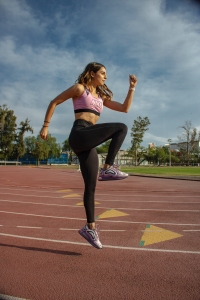
Plyometrics are a form of training that often require fast lengthening of a muscle before a contraction to perform a movement. They often involve jumping, bounding and hopping in various different activities. Hopscotch is the perfect example of this form of exercise used during our early years. This form of exercise is regularly performed in an elite sport setting to help to reduce injury but also improve performance.
How do plyometrics work?
When performing plyometric movements, muscles will go through a stretch as well as an accelerated shortening contraction. During the lengthening / stretching phase, energy is stored within the muscle and the connective tissues, then as the muscle goes into a shortening contraction, the energy previously stored is recovered to contribute to the explosive movement. This is likened to the stretching of a spring before a release back to its natural position. The more we use this style of training, the better we become at storing that energy and our ability to release energy quickly to perform a movement.
Why should runners use plyometrics in their training?
The benefits are clear for basketball players and long and triple jump athletes as to increase their ability to jump vertically or for distance. But why should it have a place in your run training routine?
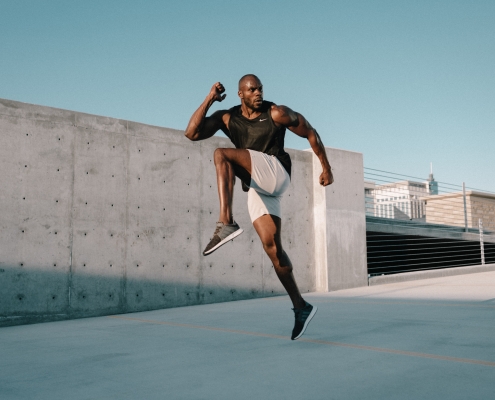 A large focus of plyometric training is being able to produce the most possible force with the least amount of ground contact time, whilst not losing all the energy you’ve created into the ground. Sound familiar? This is exactly what we go through with running. It’s all about becoming efficient with each contact we make with the floor and taking that efficiency in to the next stride. So, whether you’re struggling for speed with your runs or find yourself having heavy contacts into the floor, plyometrics could take your running to the next level.
A large focus of plyometric training is being able to produce the most possible force with the least amount of ground contact time, whilst not losing all the energy you’ve created into the ground. Sound familiar? This is exactly what we go through with running. It’s all about becoming efficient with each contact we make with the floor and taking that efficiency in to the next stride. So, whether you’re struggling for speed with your runs or find yourself having heavy contacts into the floor, plyometrics could take your running to the next level.
Where to start?
There are no official requirements to start plyometric training, however those who have experience in running and have also participated in some form of strength training will be at a good level to start adding plyometrics to their routine.
If you’re interested in learning more about how to apply plyometric training to your run training safely and effectively, contact the clinic on 01454 540066 to book a gym session with Dan.
Swim Training with Toys
/in Triathlon training/by Pete TangTools are useful for all sorts of training, right?
Well yeah, if you use them correctly. I very rarely use any toys while I’m swimming – or coaching – but here are a few bits and pieces that if used correctly, can be a really useful addition to your sessions.
Pull Buoy
I like to make a joke about how triathletes tend to use pull buoys as a crutch, but a leg float can be a really potent tool to use. The idea with the item is that you isolate your arm muscles and DON’T KICK. It kills me when I see swimmers with a float between their legs and kicking as per usual! If using one of these there are two elements at play – firstly you don’t have to worry about your legs (or body position), so you can really work on what your arms are doing under the water; Secondly you can build in some power and resistance (because the shape of the float sticks below the body, it adds to your frontal profile – the bit that causes resistance) and so strengthen your arms. Obviously in the long run this should make you go faster – but in no way should you be swimming faster with a float than you do without it! If this is the case you really need to think about your BODY POSITION!
One way of getting the most out of your pull buoy is to change the position that you hold it in – and even do some pull sets (i.e. arms only) without a float. This gives you the advantage of feeling your body position change in the water and having to balance yourself somewhat. Try placing the float between your knees, between your shins or even squeezing it between your feet.
Hand Paddles
Hand paddles are your real strengthening agent in the water. If you don’t have access – or time to go to the gym, using a pair of paddles (sparingly) can build the power in the lats and arms. They can also be used to focus on technique as well. I would always recommend to use paddles with out the wrist strap – or side straps depending on the brand of paddle – and solely use the finger straps at the top. The reason for this is simple: If you are fully secured to your paddle, then your hand can do what it likes underwater, potentially with no benefit to you, or maybe even increasing risk of injury. If, however, you were to only keep the finger straps on, you would HAVE to ensure that your paddle/hand and forearm are always engaging pressure on the water and causing the paddle to stick to your hand.
Using paddles adds to the water and resistance you can push – so will make you go faster while you are using them. But be careful of doing too much with them, you don’t want to over stress the shoulder muscles and the tendons around the elbow.
Swim Fins
Swim fins are great for those with rigid ankles – potentially from cycling or running background – as they lengthen the foot and help to increase the range of motion within the ankle. This along with regular kick will help build up efficiency. As a competitive swimmer myself (and a strong kicker), my old coach went by the maxim that around 40% of our sessions should be kick! Now for the majority of Tri Coaching followers, that will seem like a lot, especially for triathletes who feel that they don’t kick much and want to save their legs for the bike/run. I would put it to you that you want any kicks that you do make, to be strong, efficient and propulsive, and giving a good platform for you to pull from; that doing a couple of hundred metres a session kick is really beneficial to your leg mobility and flexibility, as well as your swim power.
Front Mounted Snorkel
The last training toy is the front mounted snorkel. The reason that I picked this tool out is because it helps you as a swimmer to keep your head still. I regularly make the joke that breathing is overrated, but with regards to swimming, it really is. All the time that you keep your head down, your stroke remains the same, unchanged, constant. As soon as you turn your head to breath, that is when things start to change – and if you are swimming open water, where you are likely to go off course. By occasionally using the front mounted snorkel to keep your head still (and watch your hands come through under your body), you can ingrain some really positive strong habits.
If you feel like this is too easy, or you want to build up your lung strength, Finis also do a cap to go on the top to restrict airflow(!).
All these tools are positive additions to your sessions – potentially – if used correctly, if used sparingly. Unlike on the bike, where shiny kit can make you go faster in training and in races, swim tools will only help you in training, the benefits will only cross into races if you use them correctly.
You might notice that I haven’t mentioned kick boards/floats. The only time I ever use floats are with complete learn to swim beginners, and even then I try to avoid it if possible. By using floats for doing kick, the body becomes completely out of alignment and disrupts the use of the kinetic chain, and doesn’t allow efficient, powerful or propulsive leg kick.
Some great info from John
Check out his site, www.tri-coaching.co.uk
Bored of RUNNING SLOW…?
/in Triathlon training/by Pete TangDon’t get stuck with just one pace!
There’s a funny phenomenon in endurance sports that I like to call “becoming a one-speed athlete.” It happens to runners, cyclists and triathletes whose training becomes so focused on sustained efforts at race intensity that their ability to work at higher intensity levels disappears!
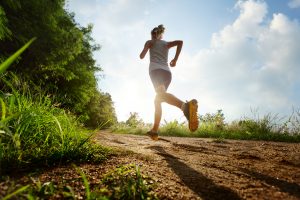
Summer Running
Their low end capabilities also become nullified because of the idea that the athlete needs to perform at “race” speed, or work hard. The one-speed athlete phenomenon presents itself most notably when endurance athletes do shorter races and feel annoyed by proving unable to go any faster over the shorter distance than they intend to go over the longer. A great, gaping hole in their fitness is revealed for all to see.
A recent example involves Ryan Hall, the brilliant young American distance runner who set a new American debut marathon record of 2:08:24 in London. That’s 4:53 per mile. A few months later, while in the thick of training for the U.S. Olympic team trials marathon, Hall ran the U.S. Outdoor Track and Field Championships 10,000 meters, finishing seventh with a time of 28:51. That’s 4:38 per mile, or just marginally faster than the pace he was capable of sustaining for another 20 miles. That’s the one-speed athlete phenomenon for you.
The problem with becoming a one-speed athlete is that it hinders performance in long-distance races as well as in shorter ones. Here’s how: Recent research has shown that rating of perceived exertion (RPE)—not heart rate or blood-lactate level or any other physiological factor—is the best predictor of fatigue during exercise. In maximal efforts over any distance, the athlete’s RPE increases linearly throughout the event, consistently reaching a level 6/7, or “hard”, rating after 20 percent of the distance has been covered and peaking at a level 10, or “maximal”, rating when the finish line is within sight. (The only exceptions to this pattern are beginners who are inexperienced in how the body feels and as a result lose the effect that makes RPE such a reliable fatigue predictor in experienced athletes).
Athletes improve by training in ways that make a pace that once felt hard at the 20-percent mark of a given race distance seem slightly easier in the next race—thus enabling the athlete to sustain a faster pace while working at the same RPE. This change occurs as a natural result of everything you do in a sensible training program. For example, simply increasing the amount of basic aerobic training you do will increase your aerobic capacity and efficiency, enabling you to race faster with equal perceived effort. But there are also specific things you can do to exploit the relationship between RPE and fatigue to your benefit. One of these things is performing hard workouts at pace levels exceeding your race pace so your race pace feels easier. When you cut back on such training too much in the pursuit of peak performance at long distances, your brain will hit the panic button when you try to race faster at shorter distances, causing your RPE to spike and therefore limiting your pace perhaps more than necessary. Hence the one-speed phenomenon. But your performance at longer distances also will be negatively affected by too much training specialization at your race pace. Exposing your body to fatigue in prolonged efforts at faster paces will result in nervous system changes that push back the wall of fatigue in your long-distance peak race.
Long, slow rides and race-pace rides of course have their place in the bike training of long-distance athletes, but these workouts need to be supplemented with others that expose your body to fatigue at slightly higher intensities.
Don’t become a one-speed cyclist. Incorporate faster/harder workouts into your training for long-distance races and reap the benefits on race day.
Take-home message
Long, slow rides/runs and race-pace rides certainly have their place in the training of long-distance athletes, but these workouts need to be supplemented with others that expose your body to fatigue at slightly higher intensities.
Recording Your Mindset
/in Articles, News, Triathlon training/by Pete TangIf you’re like most athletes, I’d guess you’re keen to experience regular improvement in your endurance, speed and enjoyment of training.
So I was wondering…do you keep a training log? 
It’s a widely accepted fact that keeping an ongoing summary of your workouts can shine valuable light on recurring themes and patterns that are either supporting your improvement, or preventing it.
So if you don’t, start now.
(Obviously I use Triblogs to track everything.)
And when you do store the info, what do you include?
The most common areas are distance, time, pace, heart rate and description of the workout.
Smart athletes also record how they felt, for example, things like ‘sluggish’ ‘heavy legs, avoid the curry the night before…’ or ‘really good and light on my feet’.
But those that make the most steady improvements, that overcome ‘plateaus’ and shake bad habits quickly, also track their mindset from each session.
I would encourage you to do the same, starting now.
Here are 3 ways to build awareness of the pattern of your mindset and its impact on your experience.
1. Nature of your thoughts – were they more positive, more neutral or more negative?
Triathlon training is often a time to escape other parts of life and our mind uses this time away to think things through. But if you bring stress, worries, a massive to-do list into the pool or road, that is like wearing ankle weights. Without realizing it your posture, effort and technique is likely to be suboptimal and you end up feeling extra drained at the end of the session.
Even if you do have challenges in your life, you always have the choice to be fully present in your workout and focused on making it a positive session.
2. Direction of your thoughts – was your mind going to distractions or performance cues? What were you focusing on?
It’s ok to let your mind wander somewhat but if you never direct your attention to how you’re executing, do you think you will improve as much as you can?
Stay engaged in your workout, set goals for each workout and have a plan to make it a great one! Obviously sometimes it’s really worth going out to escape life – we all do it. But make sure that the majority of sessions are done with an aim in mind, training toward a particular goal.
3. Number of thoughts – was your mind racing or was it fairly calm? How much mental energy were you expending in that workout?
When you catch yourself rushing in your mind or becoming overloaded with thoughts, gently bring your focus back to the purpose of the session and keep a nice steady breathing rhythm. Avoid the habit of checking your watch every minute and instead use your training to clear your mind, to release tension and enjoy the time you have.
Get in Contact
We understand that people often don't know what we do or how we can help. Don't worry we're here to help.
To ask us a question or to book an initial appointment simply call 01454 54 00 66 and one of our friendly team at will assist you with your enquiry.
Alternatively, please fill in the form on the Contact page.
Search the Website
Testimonials
"This was the first time visiting a sports massage, needed due to an injury to my calf. After just 1 session the improvements made have been incredible, and I am already booking more sessions in immediately. Matt Williams, who looked after me, was very friendly and extremely Knowledgeable..."
- Matt Lansdown

